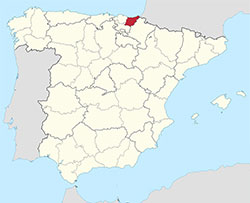San Sebastian in Guipúzcoa

Guipúzcoa is one of the three provinces that make up the autonomous region of Pals Vasco, the Basque Country. It is also Spain’s smallest province, covering only a surface of 1980 km2 (764 sq. miles). With its 720,592 (2018) inhabitants, the province of Guipúzcoa has the fourth highest population density in Spain.
It is situated in the eastern most corner of the Cantabrian Sea and borders on France, Navarra, Vizcaya, Alava and the Bay of Biscay. The highest point in Guipúzcoa is in the Sierra de Aizkorri which reaches 1,528 m.
Guipúzcoa's intense green countryside is an emblematic trait; this is a product of the province’s oceanic climate with its very limited thermal range and abundant precipitations, especially in autumn and early winter. The annual rainfall amounts to between 1,200 and 1,700 mm.
This is one of the few Spanish provinces whose history has not been touched by the Al Andalus realm, and the Romans only made it to the very eastern part with a settlement in the city which is today known as Irün. The capital of Guipúzcoa is San Sebastian, which is home to 186,665 (2018) Guipuzcoanos.
 The city was founded in 1180 by the Navarran king Sancho el Sabio (Sancho the Wise) near a large monastery devoted to San Sebastian, and took its name from this. Being known all over the world and the rest of Spain as San Sebastian, the city does actually have a completely different official name in Euskara: Donostia. But this again has the same origin. San Sebastian in old Euskara was ‘Done Sebastiáne’ which through the centuries and various ways of speaking (Donasa astiai, Donasastia, Donastia) has finally become Donostia.
The city was founded in 1180 by the Navarran king Sancho el Sabio (Sancho the Wise) near a large monastery devoted to San Sebastian, and took its name from this. Being known all over the world and the rest of Spain as San Sebastian, the city does actually have a completely different official name in Euskara: Donostia. But this again has the same origin. San Sebastian in old Euskara was ‘Done Sebastiáne’ which through the centuries and various ways of speaking (Donasa astiai, Donasastia, Donastia) has finally become Donostia.
San Sebastian had its ‘Belle Epoque’ at the end of the 19th century and the beginning of the 20th. When King Alfonso XII died in 1885, his widow, Queen MarIa Cristina, who acted as regent until her son was old enough to rule, moved the court to San Sebastian every summer, to the Palacio de Miramar.
Queen Maria Cristina’s summer courts in San Sebastian did the city a world of good. The modem architectural development that took place there in those years, plus the construction of a casino in 1887 and the city’s stunning La Concha beach were all factors that helped attract visitors from all over Europe long before any other areas of Spain turned into tourist destinations.
Indeed, when the First World War broke out in 1914, San Sebastian turned into one of the most cosmopolitan cities in Europe with the names of the day such as Mata Han, Leon Trotsky, Maurice Raval and the like holding court there.
There were performances by the French Operetta Company, the Russian Ballet and stars from the international opera scene. Queen Maria Cristina spent all her summers in San Sebastian from 1885 until 1928, the year before she died, and the council made her an Honourable Mayoress in gratitude for all she had done for the city.
Early on in the Spanish civil war, San Sebastian fell into the hands of the Falangists, and afterwards the city acquired a central role in Franco’s government. Just like Queen Maria Cristina, the Generalissimo spent every summer there until his death in 1975, turning San Sebastian into the Summer Capital of Spain.
Modern day San Sebastian is still an extremely popular tourist destination, and the La Concha Beach was recently voted the best in Europe and the sixth best in the world. This. combined with international events such as the International San Sebastian Cinema Festival, the San Sebastian Jazz Festival and the Quincena Musical, a classical music festival and the world’s oldest music festival, has contributed to making the city a magnet for beach lovers and cultural tourists alike.


